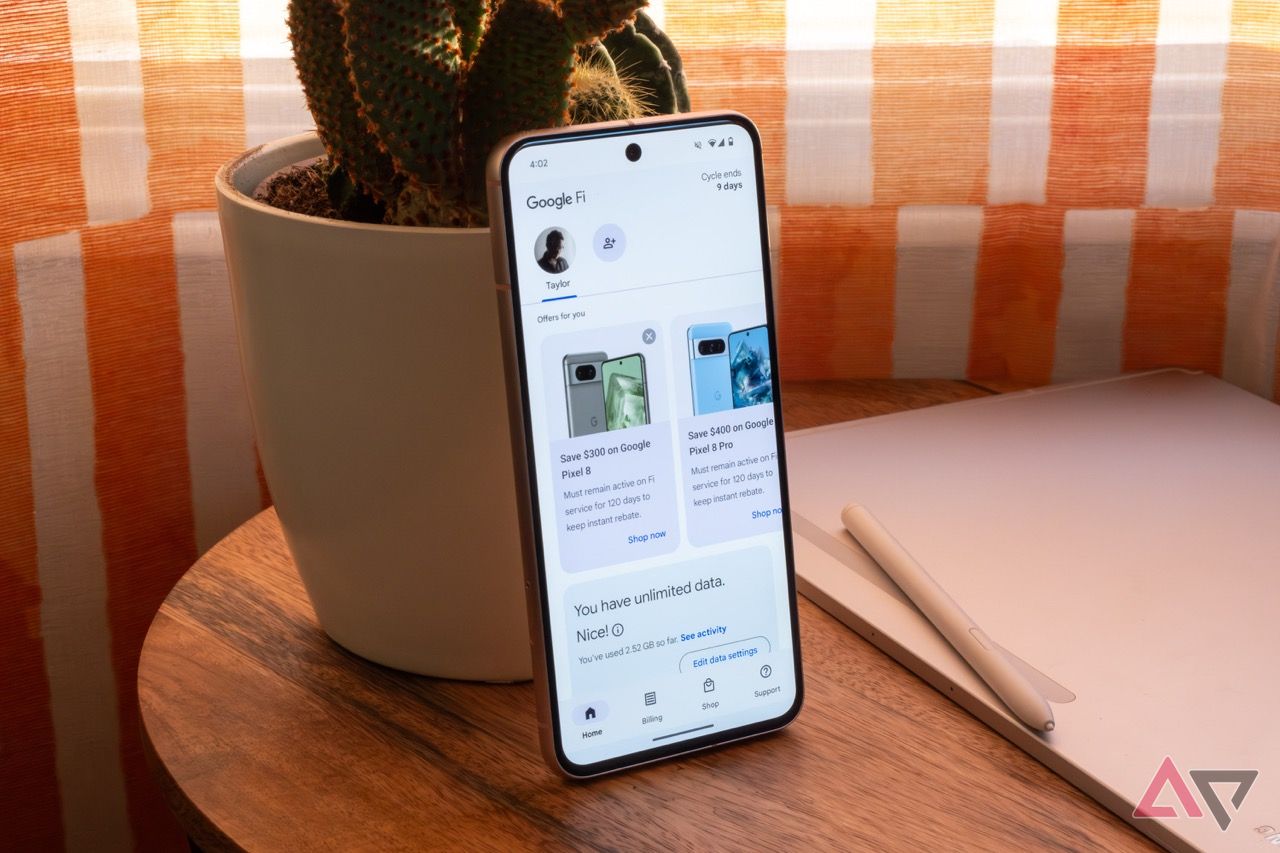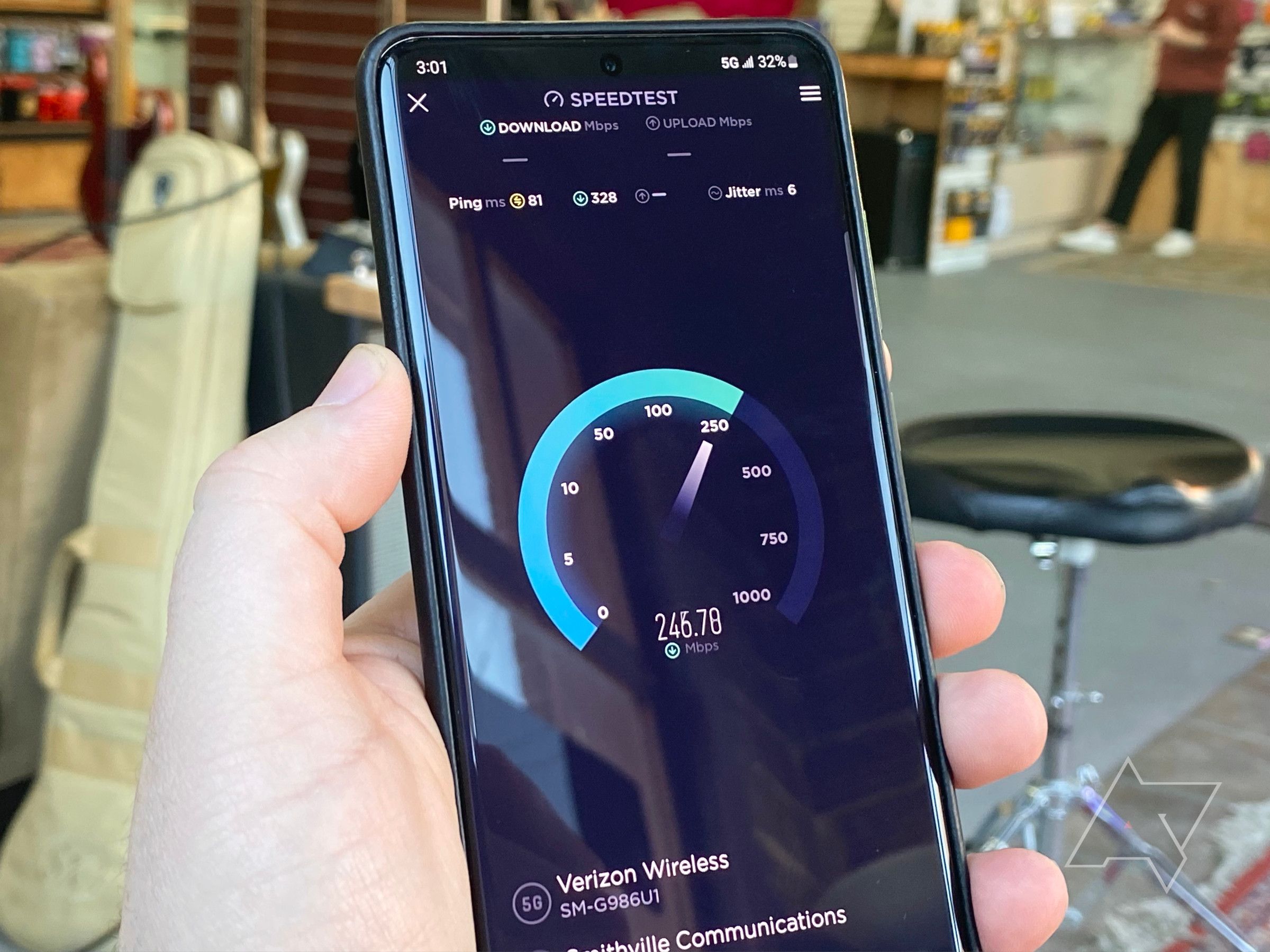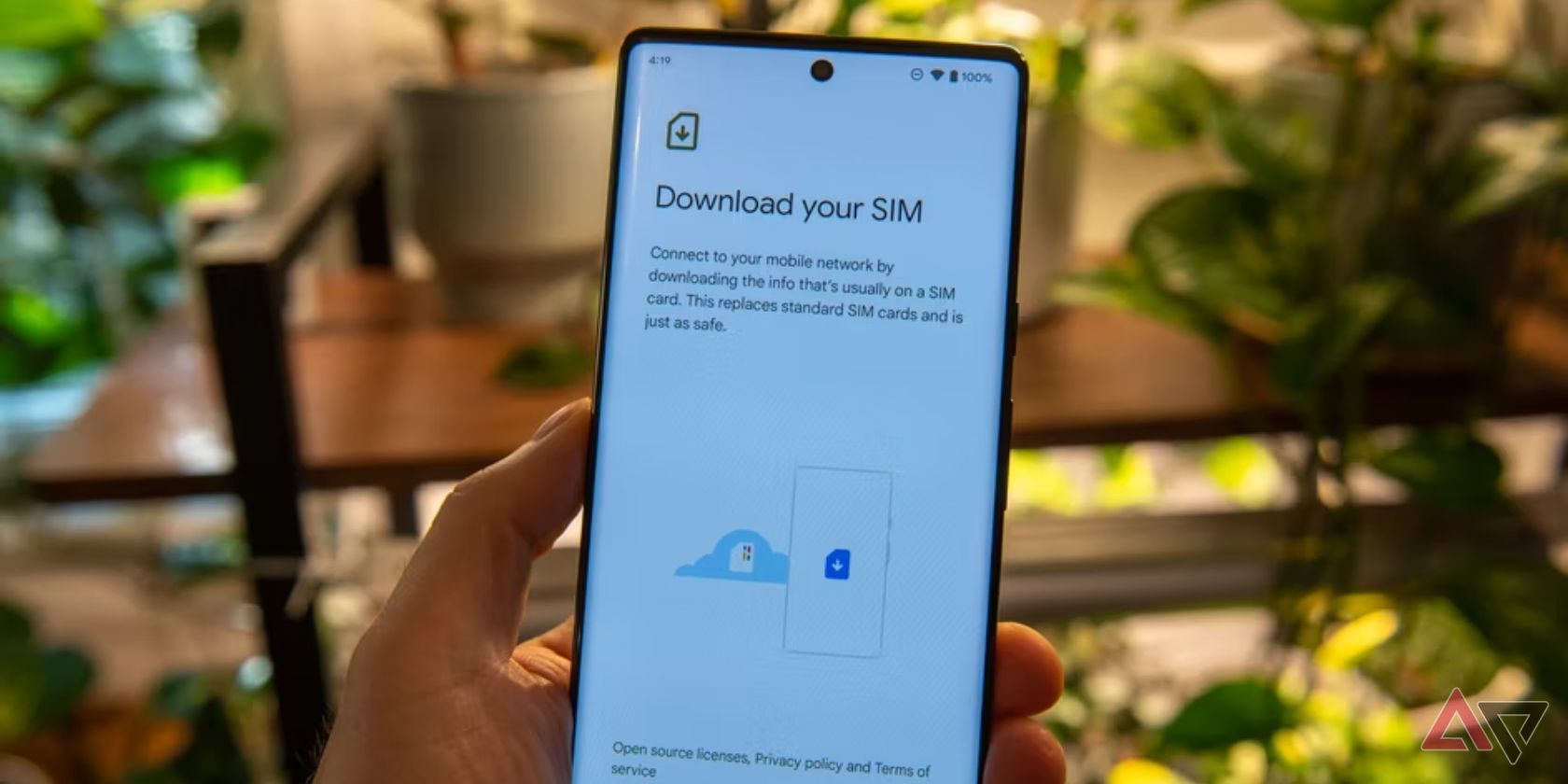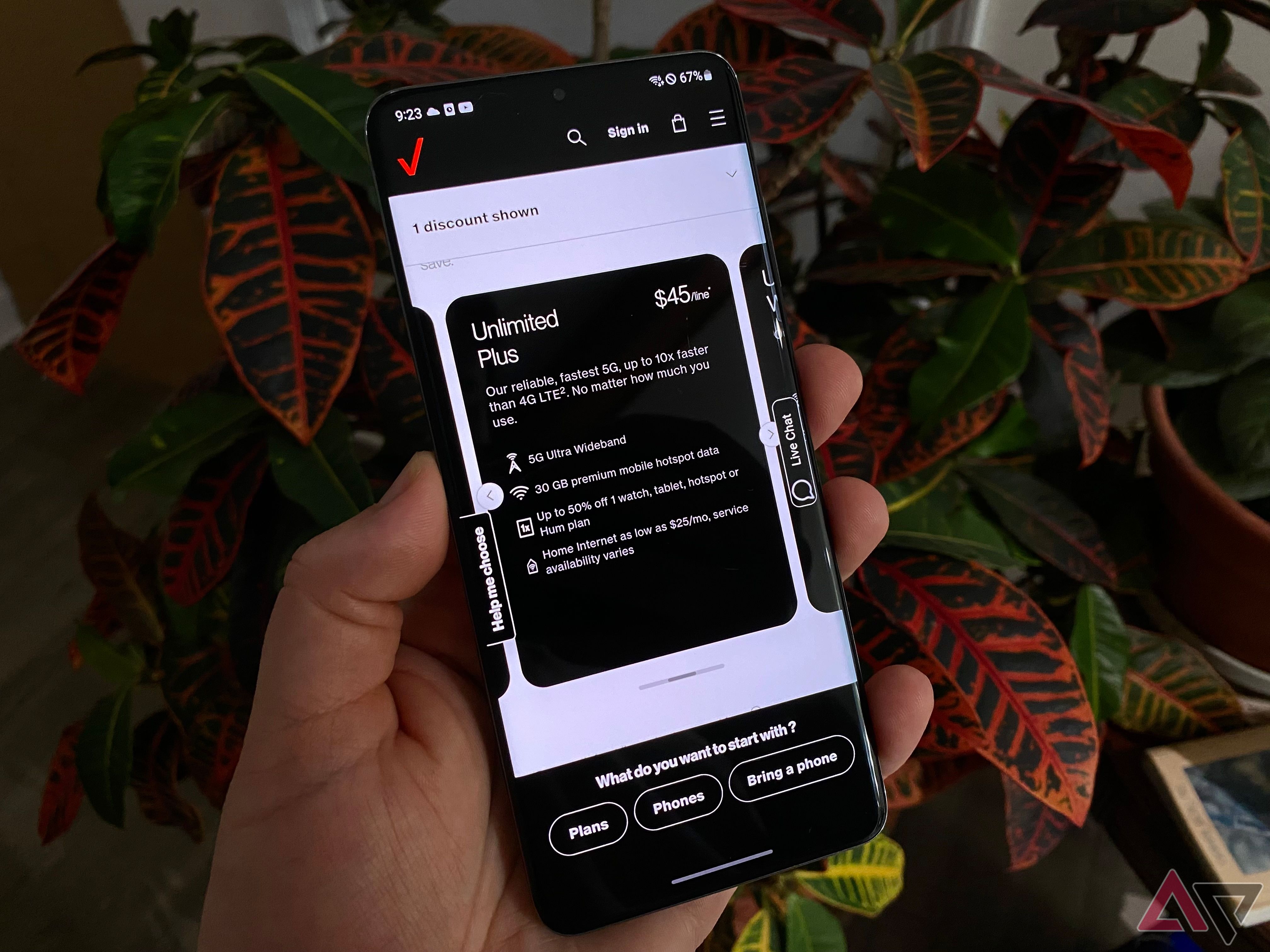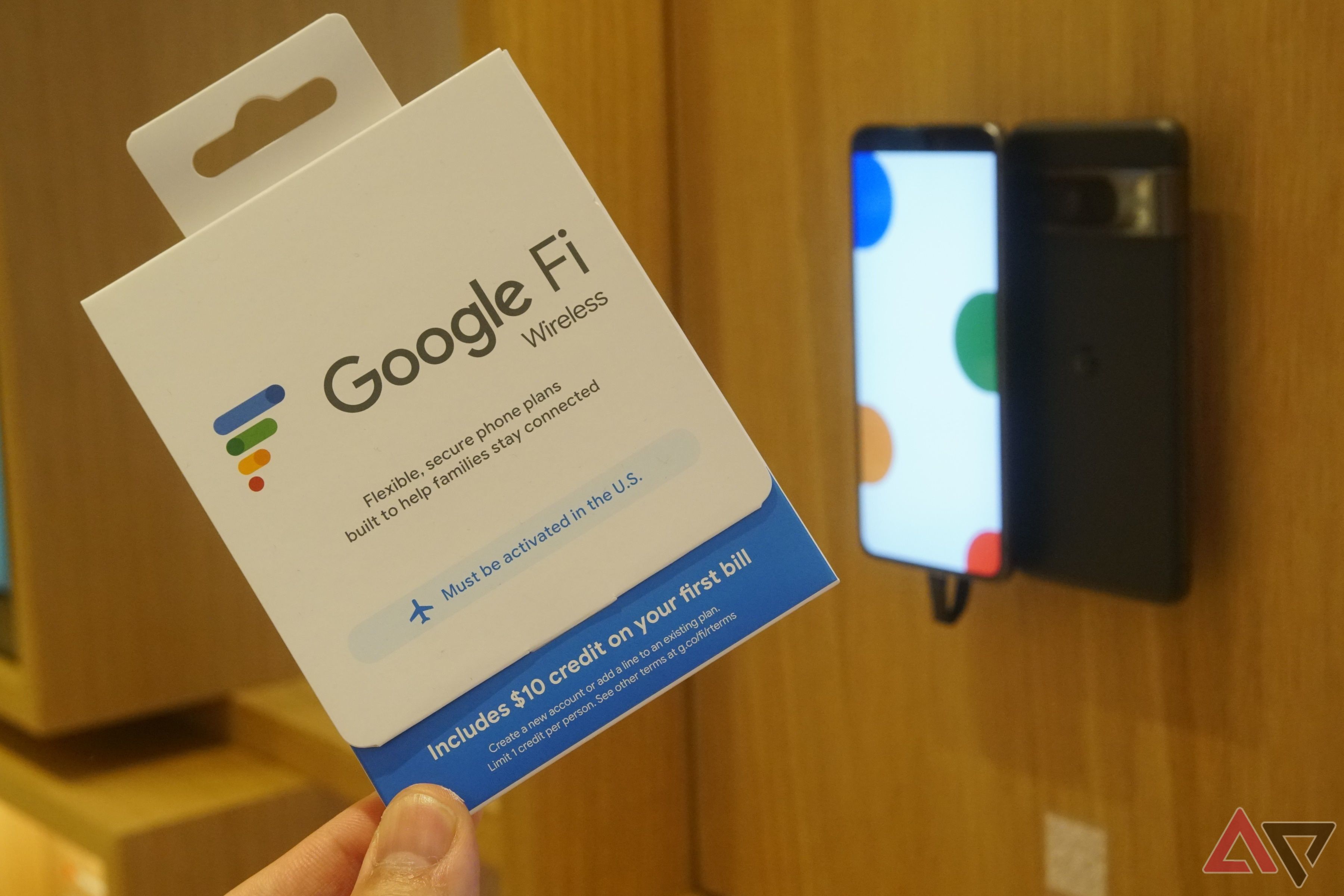-

Verizon
Unlimited premium data
Verizon’s simple unlimited plan structure, multiline discounts, and options add-ons make it easy to get exactly what you need from your plan. All plans come with unlimited data and 5G access, but how fast that data is depends on which plan you pick.
Pros- Simple plan structure with optional add-ons
- Home internet savings with a mobile plan
- Multiline savings with each plan
Cons- Plans can get very expensive
- Device savings scale with the plans
- Taxes and fees are extra
-
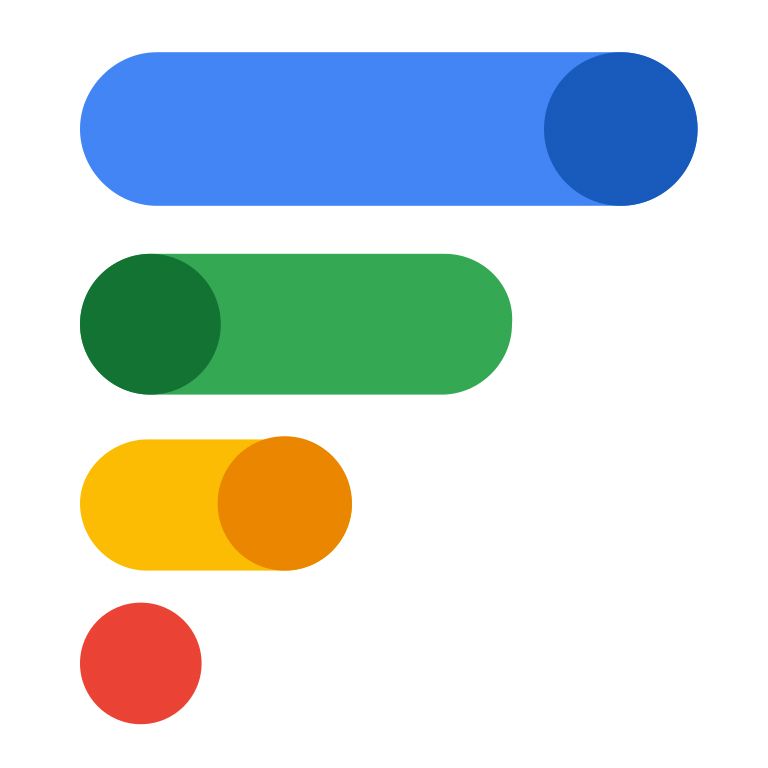
Google Fi
International coverage
Google Fi sticks to just three plans with two unlimited options and a cheaper flexible plan. Google Fi offers up to 50GB of high-speed data with international features, free smartwatch connectivity, and hotspot data on every plan.
Pros- International data usage on Unlimited Plus and Flexible
- Multiline savings available for family plans
- Hotspot data on every plan
Cons- Unlimited plans stream video at 480p
- All lines must be on the same plan
- Taxes and fees are extra
Whether you’re looking for international data or just want tight Pixel phone integration, Google Fi is an appealing carrier. If you need a lot of data, however, Verizon starts to make a lot more sense. With no cap on its plans, you don’t need to worry about your data being slowed due to heavy usage. Both plans feature multiline discounts, so if you’re bringing the family along, you can get some extra savings. Keep in mind, though, that all members need to be on the same plan with Google Fi, while Verizon customers can mix and match plans to fit individual needs.
When it comes to pricing, Verizon averages out a bit higher but comes with more data overall. Neither carrier includes taxes and fees, so your actual price will end up a bit higher than the plan’s cost. Even so, the carriers offer solid phone discounts on new models, though Verizon has far better support and discounts for iPhones. If your whole family is on Android, however, you’ll have no trouble finding something that works great with Fi.
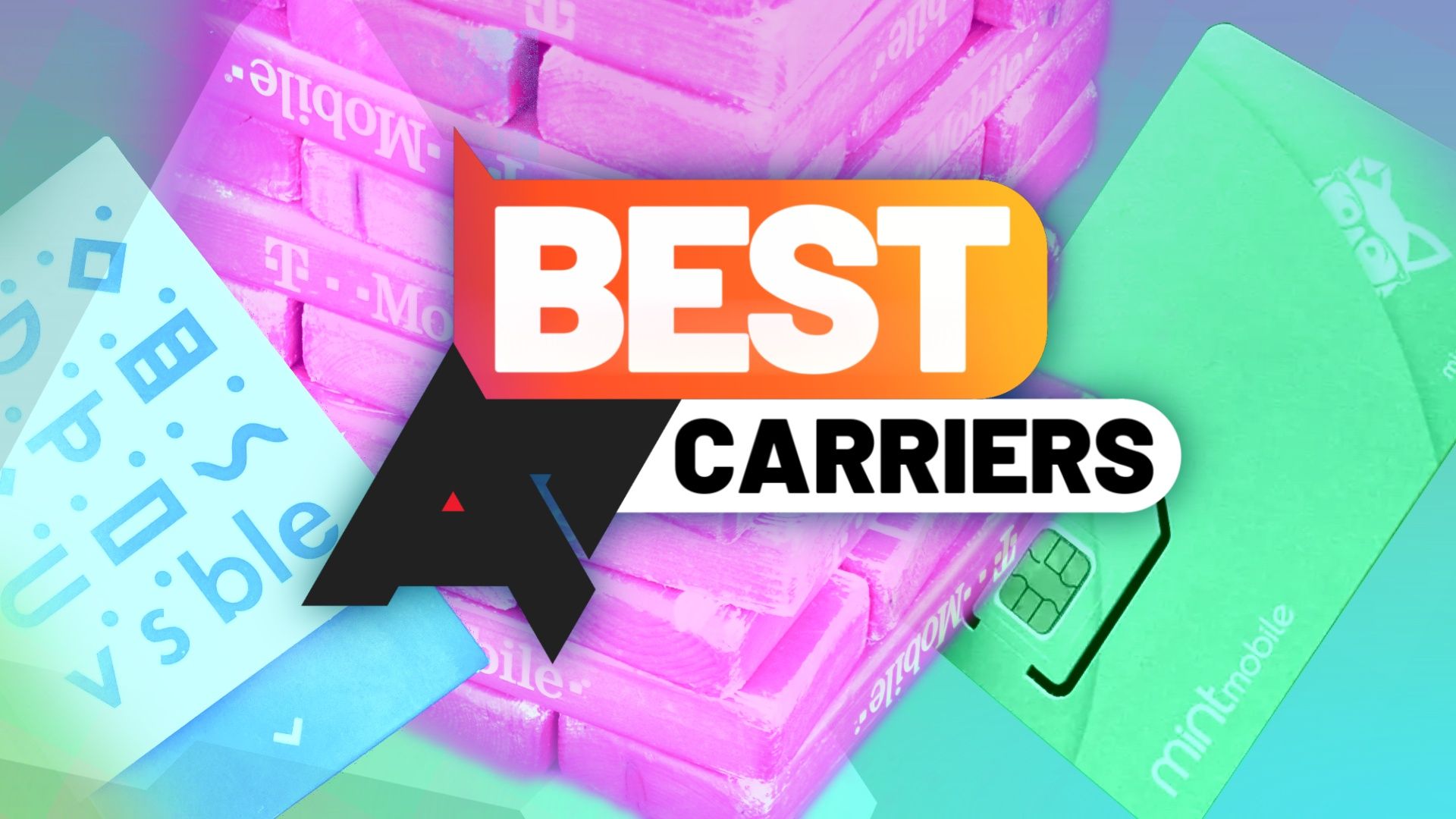
Best phone carriers in 2024
There are a ton of plans to choose from, but the best network mostly comes down to coverage in your area
Mobile carrier features
Verizon is a postpaid carrier that builds and maintains its own network infrastructure, so it makes sense that the carrier can offer a ton of fast data on its plans. For instance, its cheapest plan comes with totally unlimited data on Verizon’s slower 5G network, while its two faster plans get unlimited premium data on Verizon’s fastest 5G connection. If you’re looking for pure speed, there’s a good chance Verizon will have the advantage in built-up areas.
Verizon also offers 5G and fiber home internet plans for many customers, and if it’s an option for you, you can save by bundling it with your Verizon plan. Naturally, the pricier plans get a bigger discount, but it’s still nice to have the option. Speaking of plans, Verizon allows customers to mix and match plans, so they can choose the plan that makes the most sense for each family member. For example, Mom and Dad may need hotspot data for their tablets on bigger plans, while the kids may not need any extra data at all and can get by with a cheaper plan. On Google Fi, all lines must be on the same plan.
Verizon’s plans really start to make sense when you get a look at the add-ons. Rather than creating bundles with streaming features or international passes many people don’t need, Verizon has simplified its plans to the basics, allowing customers to choose add-on services for $10 each. This can be something like a Disney+ or Apple One subscription or even more data for your plan, like the 100GB hotspot add-on.
Google Fi also has three plans, but it’s much more varied in what it includes. On the Flexible and Unlimited Plus plans, for example, you can get a data-only SIM to use your data on another device. These plans also include international data in 200+ countries that doesn’t cost any extra.
All Google Fi plans support free smartwatch data, as long as you want a Pixel Watch or Galaxy Watch, that is. Google Fi doesn’t support Apple Watch data. Fi uses the T-Mobile network for most of its data, with some Wi-Fi coverage in dense areas. The nice thing about Fi is that you don’t need to worry about which network you’re on, and if you have a fairly popular Android phone, like a Google Pixel, Motorola, or Samsung Galaxy, it will likely handle all the network switching automatically. Google Fi also has some nice features like a VPN that you can use on public Wi-Fi to stay secure while you save data.
Finally, Google Fi’s app makes it easy to manage your account or even change your plan in just a few minutes. If you’re planning a trip abroad, you can upgrade your Fi plan to one with international data, for example.
Coverage and reception
Verizon builds its own network, and while T-Mobile gained an early lead in 5G coverage and performance, Verizon has been rapidly building out its mid-band coverage and has made up a lot of ground, especially in urban and suburban areas. Verizon calls its mid-band and mmWave coverage Ultra Wideband 5G or 5G UWB. Most people will have strong coverage on the Verizon network and those living in the country will appreciate the carrier’s strong rural coverage.
Despite full control of its 5G network, Verizon only allows full access with its two priciest plans. If you sign up for Unlimited Welcome, for example, you’ll only get nationwide 5G speeds. While this is plenty for most tasks, you may notice the lower speeds on large downloads, like games. Verizon also limits video streaming resolution on its plans, so you’ll get 480p videos on Unlimited Welcome, 720p videos on Unlimited Plus, and full 1080p videos on Unlimited Ultimate. If you’re connected to the UWB network, there’s no video quality limit.
Google Fi uses T-Mobile’s network for the majority of its coverage. While it used to also use Sprint and US Cellular, most people on Google Fi will be connected to T-Mobile. In some urban areas, T-Mobile has made deals with public Wi-Fi providers to supplement its coverage. This will show up as a W+ icon on phones instead of 5G or LTE, and it still counts towards your data.
T-Mobile doesn’t restrict which 5G connection type Google Fi customers can use, so they’ll likely see strong mid-band 5G speeds in urban, suburban, and some rural areas. T-Mobile’s 2.5GHz mid-band spectrum has a better range than Verizon’s C-band spectrum at 3.7GHz, and the carrier was also able to start building the network early.
Phone compatibility
Verizon is one of the biggest carriers in the country, and, as such, most phone makers are happy to support its network. Whether you’re after a Samsung Galaxy S24 Ultra, Pixel 8 Pro, OnePlus 12, or even an iPhone 15 Pro, it will work great on Verizon with full 5G support. Most phones designed for North America will work on Verizon, though some international models may lack some of Verizon’s bands, leading to reduced coverage and speeds. Still, if you’re looking to buy one of the best Android phones to use with Verizon, you’re spoiled for choice.
To determine if a phone will work, enter your phone’s IMEI in Verizon’s BYOD tool. If your phone is unlocked, and you want to see how the network will actually work in your area, you can start a 30-day free trial of Verizon’s network.
Since Google Fi uses the T-Mobile network, most phones are compatible. That being said, the level of support you get with Fi can vary by model. Compatible phones will either be labeled as compatible with Fi, or designed for Fi. Designed for Fi phones get network switching, which means access to the W+ coverage. Any Android phone compatible with Fi supports international data and extra security with a VPN. You can check your phone with Google Fi’s compatibility tool.
On Fi, iPhones are technically supported but require manual configuration to send SMS and MMS messages. Fi will provide step-by-step instructions to set the phone up, but it’s still a bit of a pain to get going and must be redone every so often. Overall, iPhones work on Google Fi, but it’s far from ideal.
Plans
Like most of the best data plans for smartphones, the right plan on Verizon or Google Fi comes down to how much data you need, how many lines you have, and whether you need international service. For most people, Fi’s largest Unlimited Plus plan has plenty of high-speed data at 50GB, but if you need more than that, Verizon’s plans have no limit.
There are also some big differences when it comes to devices other than your phone. Google Fi offers free smartwatch data for a handful of smartwatches and a data-only SIM, while Verizon supports smartwatch plans as add-ons and also offers home internet service with fiber or 5G. If Verizon Home Internet is available in your area, you could save overall by bundling both services.
Verizon’s plans
Verizon’s three plans are collectively referred to as myPlan, and from the ground up, they’re designed to be customized. Verizon’s three plans are more like starting points, offering unlimited talk, text, and data with add-ons available for $10 each. Generally, these add-ons are a solid value, especially as streaming services continue to increase prices. For example, you could get the Disney Bundle with Hulu, Disney+, and ESPN+. Apple users could get Apple One or Apple Music Family for that same price. There are also more traditional add-ons such as smartwatch data or 100GB of hotspot data.
With the cheapest plan, Unlimited Welcome, customers get unlimited data on Verizon’s nationwide 5G network. That means no Ultra Wideband 5G, so speeds will be more in line with LTE, which is fine for many people. Video streaming is limited to 480p and there is no premium data or hotspot data. You do get unlimited usage in Mexico and Canada at least. If you’re looking for savings on a new phone, this plan gets the least. If you’re bringing your own phone, this plan also gets the smallest promo credit. Unlimited Welcome comes in at $65 for a single line but is much more affordable with more lines. With four lines, Unlimited Welcome costs $30 per line.
Unlimited Plus adds unlimited premium data to the mix to keep speeds high with network congestion. You get 30GB of high-speed hotspot data and data usage in Mexico and Canada. Videos also stream at 720p with this plan. As you might expect, new device savings are better on this plan, as well as the promo credit for bringing your own device. For a single line, this plan costs $80 per month, but is a more reasonable $45 per line if you bring four lines.
Verizon’s most expansive plan, Unlimited Ultimate, includes all of the above, with hotspot data upgraded to 60GB, international usage in 210+ countries, and the best device savings. Video streaming also gets bumped up to 1080p. At $90 for a single line, this plan is expansive, and at $55 per line with four lines, this plan is still expensive. If you need the hotspot data or international features, it could still be worth it for some, especially since Verizon lets you mix and match plans.
|
Unlimited Welcome |
Unlimited Plus |
Unlimited Ultimate |
|
|---|---|---|---|
|
Price (per month) |
1 line: $65 |
1 line: $80 |
1 line: $90 |
|
4 lines: $120 |
4 lines: $180 |
4 lines: $220 |
|
|
5G |
Nationwide 5G |
Ultra Wideband 5G |
Ultra Wideband 5G |
|
Talk and text |
Unlimited |
Unlimited |
Unlimited |
|
Data |
Unlimited |
Unlimited Premium |
Unlimited Premium |
|
Hotspot |
None |
30GB |
60GB |
|
Taxes and fees |
Extra |
Extra |
Extra |
Keep in mind that Verizon does not include taxes and fees in these prices. These prices also assume you’ve enabled auto-pay and paperless billing, or you’ll need to pay $10 more per month. If you’re looking for a home internet bundle, Unlimited Welcome can get service for as little as $40 per month, while Unlimited Plus and Unlimited Ultimate are as low as $25 per month.
Google Fi’s plans
Google Fi also has three plans, but they’re skewed more toward lighter users. Fi does not allow users to mix and match their lines, so everyone on your account must be on the same plan. Luckily, auto-pay is not needed for Fi’s best prices.
Google Fi’s cheapest plan is called Flexible and starts at just $20 per month. This plan includes unlimited talk and text in the U.S., Mexico, and Canada. Data is billed at $10 per gigabyte up to $80, then it’s free until you hit 15GB. At 15GB, your data is slowed until the next month or until you manually add more data. As you might expect, this plan can get expensive if you use a lot of data. Luckily, you can use that data in over 200 destinations, which makes it a good choice for international travel.
Next up, Simply Unlimited is a more traditional prepaid plan with 35GB of high-speed data and 5GB of hotspot data. This plan also works in Mexico and Canada but lacks the 200 destinations of Flexible and Unlimited Plus. Still, with a starting price of $50 for a single line and $25 per line if you bring four, this plan can still be a solid value for families.
Fi’s biggest plan, Unlimited Plus, includes 50GB of high-speed data, all of which can be used for mobile hotspots. You can use that data in 200 destinations, making it a great plan for those who travel internationally. Google Fi even throws in a 100GB plan for Google One, as well as six months of YouTube Premium for free. While this plan is Fi’s most expensive, its single-line cost of $65 is in line with Verizon’s cheapest plan. For four lines, this plan comes in at $40 per month, as well.
|
Flexible |
Simply Unlimited |
Unlimited Plus |
|
|---|---|---|---|
|
Price (per month) |
1 line: $20 (+$10/GB) |
1 line: $50 |
1 line: $65 |
|
4 lines: $65 (+$10/GB) |
4 lines: $100 |
4 lines: $160 |
|
|
Taxes and fees |
Extra |
Extra |
Extra |
|
5G |
Yes |
Yes |
Yes |
|
Talk and text |
Unlimited |
Unlimited |
Unlimited |
|
Data |
$10/GB (up to 6GB) Slowed at 15GB |
35GB |
50GB |
|
Hotspot |
Shared |
5GB |
Shared |
If you have a smartwatch from Samsung or Google, you can get it online with Fi for free with any plan. Similarly, you can get a data-only SIM for your tablet or a backup phone if you get either Flexible or Unlimited Plus.
Which should you pick?
If you’re looking for the cheapest family plan with plenty of data for most people, Google Fi’s Simply Unlimited plan comes out on top. While its single-line price isn’t exactly competitive with some of the best prepaid plans, if you bring a few lines with you, it’s a lot more appealing. While it only comes with 35GB of high-speed data, if your family makes good use of Wi-Fi, it should be plenty. The 5GB of hotspot data is also nice for getting a tablet or laptop online while away from home.
While Google Fi’s bread and butter is international service, for most people most of the time, Simply Unlimited makes a lot of sense. It’s reasonably cheap for a family to get set up, it includes Fi’s VPN and network switching features, and if you head to Canada or Mexico, it keeps working.

Google Fi
Editor’s choice
Lots of plans to choose from
Google Fi’s range of plans makes it an easy choice for an Android-only family. While its iPhone support leaves a lot to be desired, its solid multi-line pricing, network switching, and international data options make it a great choice.
If you’re looking for a ton of data, Verizon’s plan is really the best choice here. Even Verizon’s cheapest Unlimited Welcome plan comes with totally unlimited data, while Google Fi’s top plan only gets 50GB of high-speed data. Verizon also has better iPhone support. Verizon could even help you save on subscription services through its add-ons, and if it’s available in your area, Verizon Home Internet can be bundled for additional savings.

Verizon
Runner-up
Great for those who need a lot of data
While Verizon’s plans are more expensive than Google Fi, heavy users could be more drawn to its truly unlimited data. Streaming video can also be of higher quality with HD options on the two bigger plans.
Source link

